We are excited to share this Hungarian pickles recipe, along with a fascinating tale by author Jill Culiner. You can read more about her below.
No pickles could be as wonderful as those my grandmother made. I was a devoted fan, and luckily, I don’t have a sweet tooth. You can eat all the pickles and sauerkraut you want and never put on a pound.
Unfortunately, back in my younger days, I was too smug and too silly to find out exactly how she made them, and most of the pickles I’ve since encountered have been made with vinegar, so they just weren’t right.
When I lived in Germany, I did find the equal of those my grandmother made, as well as whole heads of pickled cabbage: both, stocked in big wooden barrels, were sold on the market in Munich.
However, this was some time ago, and I left Germany in 1992. After that, my pickle frustration was hard to bear. Until I moved to Hungary.

Finding old-world Hungarian pickles
There I was, living in a small village in the east of the country. I couldn’t speak a word of the language, and I knew nothing about the culture, but I couldn’t help noticing the large, cloudy-looking jars that, in late summer and early autumn, were placed on sunny window ledges. And…they looked like they were filled with pickles. Really? Was it possible?

It was my new friend Klarika who cleared up the mystery (with much sign language, pidgin Hungarian mixed with pidgin English and pidgin German). I can guarantee that the pickles, pickled cabbage and sauerkraut that results from this old recipe are a real treat.
“I’ll never miss my grandmother’s old country pickles again because I can make them myself.“
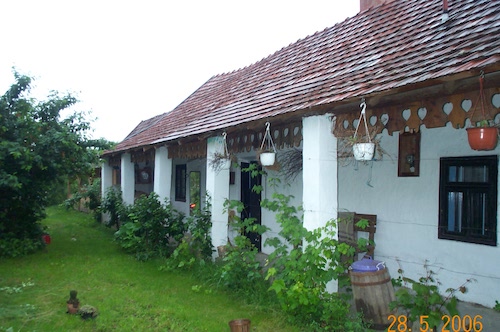
Hungarian pickles: Here’s how to go about it
For one large mason jar, take a batch of pickling cucumbers, not eating cucumbers . Slice them lengthwise twice (an X shape) without detaching them from the base. Pack them tightly into the jar. Add lots of fresh dill, several whole fresh garlic cloves, whole black peppercorns, and some juniper berries.
If you like them a bit spicy, you can also add a few tiny dried red peppers. I even add some fresh ginger for that extra tang. Now you have to add the salt and water, but since these pickles are fermented, it’s best to use bottled water: the chemicals in tap water might slow down fermentation. If you don’t have bottled water, let tap water stand overnight so the chemicals evaporate.
Heat enough water to dissolve around two heaping tablespoons of kosher salt. Then add this to enough water to completely cover the pickles. In fact, you might even have to add more salt. Yes, I know this isn’t a precise way of going about it, but just taste the water. It should be as nice and salty as the sea but not too horribly salty. That means approximately one tablespoon of salt to two cups of water.
If you have more dill, top the pickles with it, and here’s the most important part…push it all down with a chunk of good yeasty bread (rye bread or any natural crusty bread, not soft sandwich bread which will just turn into mush.) When the bread is also covered by the salty water (weigh it down with a plate or cup if you have to), cover the jar either with a piece of cloth held in place by string or an elastic band, or put the lid down loosely so that any gas can escape.
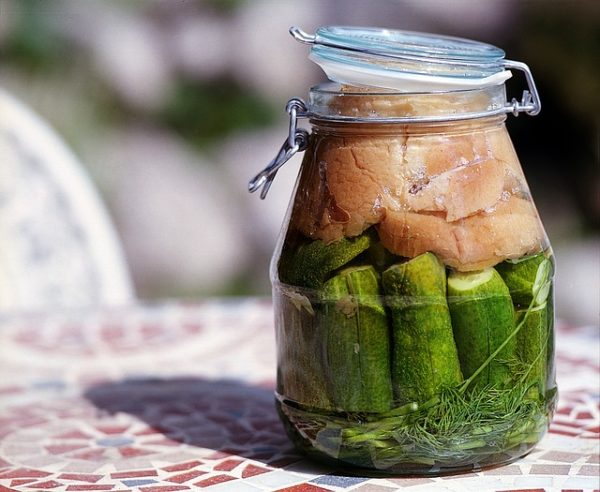
Use the sun in fermenting Hungarian pickles
Put your jar in the sun. This is strictly Hungarian. In other countries, fermented pickles are kept in a dark place, but I’ve always had success with this method.
It should start getting cloudy with little bubbles after the second day. That’s fine, because it means the fermentation process has begun. Keep checking that this is happening.
If you’re doing this inside your house, it’s best to put a plate underneath because the liquid will start seeping out. Taste your brine from time to time: it has to stay salty! If it doesn’t, add more salt. Salt keeps nasty bacteria away. Depending on the weather, do start tasting the pickles after the third day. You don’t want them to get mushy.
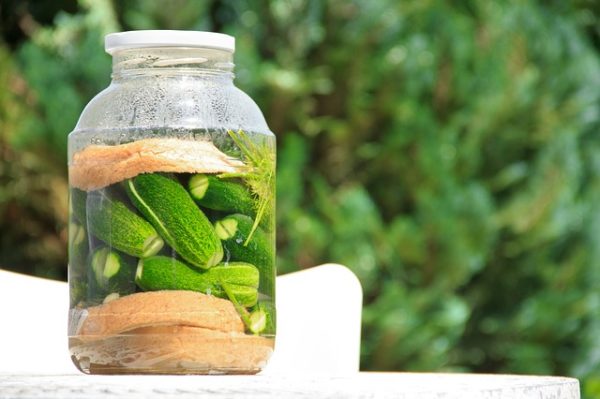
After a few days . . .
You can also remove the bread because it has done its work of getting good yeast into the jar. If the bread has gone moldy, no problem. That doesn’t affect the pickles. After four days, taste the pickles. You don’t want them to get too soft. If they are ready, put them in the fridge. If not, leave them for another day. I find they are usually ready after three days, but I suppose it all depends on where you live and the climate.

Finally . . . enjoy
After that, enjoy! Some people claim these pickles should be eaten over the next two weeks, but I’ve certainly kept them for far longer than that in the refrigerator. If there is a white powdery film over the top, that is fine. Just skim it off.
Adjusting the Hungarian pickles recipe for pickled cabbage
For pickled cabbage, it’s the same process, only you separate the leaves before stuffing them into the jar, and it will take far more time before they are ready. Cabbage will also keep for far longer than pickles. I do remember that my grandmother blanched the leaves in boiling water for a minute before putting them in the jar, but I’ve never done this.
Changing the Hungarian pickles recipe for sauerkraut
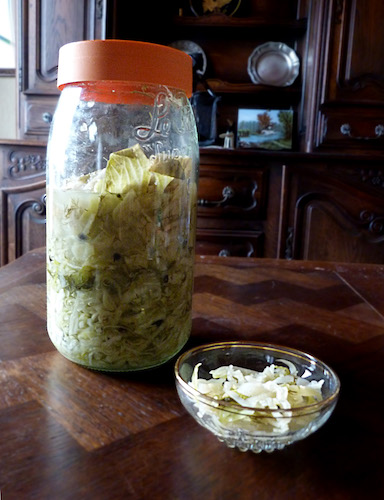
And, by the way, this is almost the same recipe I use for making sauerkraut. Homemade fermented kraut is wonderful. The only difference is, I break up the sliced cabbage by squeezing it several times and removing the crunch before putting it into the jar. This will help release the water.
I don’t put the jar in the sun, but in a dark corner, and I make sure that, after a few days, the kraut has released enough water to cover the surface. If it hasn’t, add a little bottled water and salt. It can take from two to three or four weeks to mature. Keep tasting it, and you’ll know.
Once it’s the way you want it, keep it in the fridge and help yourself whenever you have the munchies. Make sure there is always enough brine to cover the kraut, and it will still be good to eat in a year. The kraut and/or the juice can be added to soups or simply enjoyed as is! It is certainly very healthy.
Hungarian pickles recipe
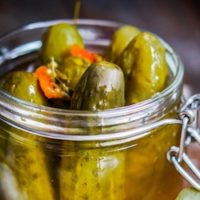
Hungarian Pickles
This recipe for old world Hungarian pickles is perfect for those comfortable with flexibility, as no precise measurements are included. The measurements are handed down, imprecise, and change with each pickle maker. This allows you to choose the perfect flavor for your Hungarian pickles.
Ingredients
Supplies
Food ingredients
- Pickling cucumbers
- Fresh dill
- Whole fresh garlic cloves
- Whole black peppercorns
- Bottled water or tap water that sat overnight
- 2 heaping Tablespoons of kosher salt
- Yeasty bread (rye bread or any natural crusty bread)
Instructions
- Slice cucumbers lengthwise twice (an X shape) without detaching them from the base and pack them tightly in the jar.
- Add lots of fresh dill, several whole fresh garlic cloves, whole black peppercorns, and some juniper berries.
- Add the salt and water.
- Heat enough water to dissolve salt, then add this to enough water to completely cover the pickles. (approximately one tablespoon of salt to two cups of water.)
- If you have more dill, top the pickles with it.
- Push it all down with a chunk of bread.
- Cover the jar either with a piece of cloth held in place by string or an elastic band, or put the lid down loosely so that any gas can escape.
- Put your jar in the sun. It should start getting cloudy with little bubbles after the second day.
- Taste your brine from time to time: it has to stay salty! If it doesn’t, add more salt. Start tasting the pickles after the third day. You don’t want them to get mushy. You can also remove the bread because it has done its work of getting good yeast into the jar.
- If they are ready, put them in the fridge. They are usually ready after three days.
Nutrition Information:
Yield: 10 Serving Size: 1Amount Per Serving: Calories: 5Total Fat: 0gSaturated Fat: 0gTrans Fat: 0gUnsaturated Fat: 0gSodium: 170mgCarbohydrates: .7gFiber: .4g
Nutritional information isn't always accurate and it will vary based on the specific ingredients used.
Read next: Pickled Cucumber Salad
Which will you try first the Hungarian pickles, the pickled cabbage or the sauerkraut?
More gluten-free Jewish-style recipes you might like
Photo credits on this page:
Except where noted, all photos are the original property of Jill Culiner.
Disclaimer: Statements regarding health benefits are not intended to diagnose, treat, cure, or prevent any disease or health condition.
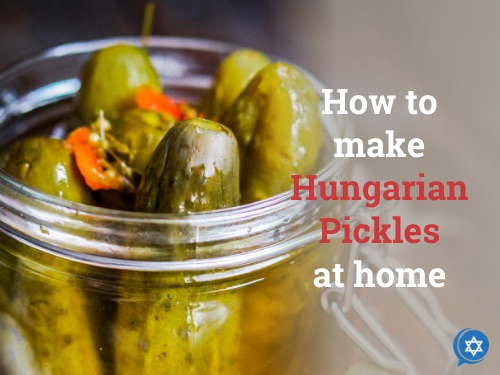

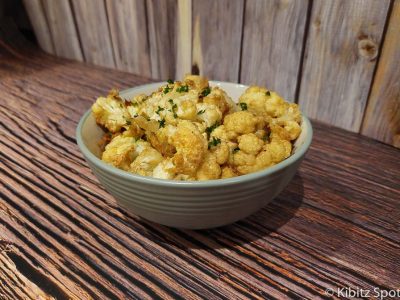
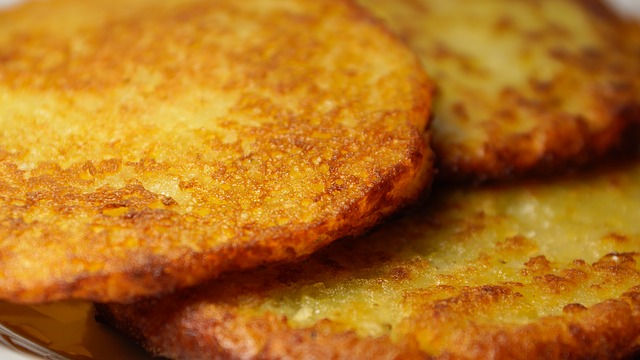
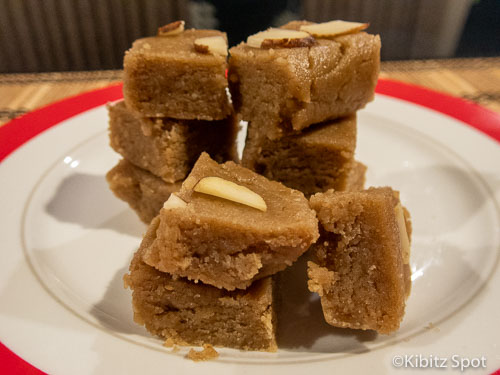

Hey ladies!
I am from Hungary living in the States and I am really struggling to decide what type of bread should I put in the jar!
I would be very grateful if you could help me out!
Thanks, Janka
Hello Janka,
I suppose any kind of bread will work. It’s the yeast in the bread that gets things going quickly. Good, natural bread is the best kind rather than industrial packaged slices which will fall apart in the jar and be a soggy mess.
However— and this is important — the pickles can be made without bread, too. The most important thing is to use bottled water or tap water that has been standing in a jar overnight. In other words, don’t worry about the bread. It’s a traditional flourish, but not a necessity.
Hello! My Hungarian born mother would always use a good, crusty sourdough bread – sometimes from a bakery, sometimes just from the grocery store.
Love these pickles, my dad was Hungarian, and made them every summer, glad I found this recipe.
A few questions …
What temperature is to hot to put them out in..
How would one tell if they didn’t work or went bad?
What If one day was really hot the next day alot cooler with clouds etc..
Thanks
Hello Kim,
No temperature is too hot. They just mature more quickly in hot sun. Clouds don’t change anything. You can make these pickles without sun. I’m making a batch in my kitchen.
When there is enough salt, the pickles don’t go bad. The only way of knowing if they are ready is by tasting them. If they aren’t sour enough for you, then leave them out for another day — but some people prefer them only lightly pickled. If you leave them for too long, then they get mushy. They’re still healthy, so when that happens (sometimes a few in the jar are softer and mushier than others) I just grind them into a cold summer soup. They add that special tang!
Why not use 1/8 teaspoon of instant yeast in place of slices of bread?
Jill shared her traditional family recipe with us. If you try it, let us know how it worked out please.
Asking this for a friend, has ANY ONE tried this with a gluten free bread? or even a yeast starter?
I’m Hungarian and most of my family is gluten intolerant but we still make it every year and it’s delicious. We always use home made gluten free bread so I’m not sure if it would work with store bought.
How long do these stay good?
I made these for the very first time. I actually didn’t even know to ferment pickles with sourdough bread. I love pickles and I love making sourdough bread!
In my life I have only ever made open kettle pickles, and have been ready to go into fermenting them, even tried last year but I was dumb and put them in a metal pot. Oops.
First go went splendid! And am getting ready for more!!
Hi Amanda,
The pickles have to be kept in a refrigerator when they’re ready (I didn’t have a refrigerator when I lived in Hungary, so I simply put them in a bucket which I lowered into the very deep garden well. Just above the water level, temperatures were icy!) Usually, people eat these pickles quickly, but you can keep them longer. However, the longer you keep them, the mushier they get, which is no fun at all. If they are completely soft and without crunch, they can be ground and used in a salad sauce—or in any recipe that might benefit from a slightly sour, fermented taste.
Thank you so much! I made them a couple times now at home. Currently, I am at my cousins home in Washington state. (I reside in eastern Nebraska)
This has been such a fun experience! And my cousin is super excited, we just finished putting together a gallon jar and is in the sun.
My mom is from Yugosalvia and my grandma used to make these pickles all the time when I was growing up. They are my favorite but I haven’t had them since my grandma passed away. I tried out her recipe this week for the first time ever and everything turned out perfectly except for they are a tad salty. It’s hard because my grandma never measured anything or followed recipes. So nothing ever turns out just right when we try making her things now! I really appreciate your article though and I’m so happy I came across it. I will be using it very soon when I give the pickles another try!
A great help for making Hungarian Summer Pickles is the book by the famous Hungarian chef, George Lang titled The Cuisine of Hungary. The latest edition was published in 1990 ( my copy ), by Bantam Books.
Very precise directions are included so that the finished pickle is perfect and no adjustment is required, except for taste preferences such as garlic or hot pepper.
My mom used to make her own pickles, have to give it a try, because I love pickles and European pickles are much more delicious, not that sour like here in North America 🙂
You’re right. Because North American pickles are made with vinegar, and that’s not at all the same thing. Good luck with the recipe.
These pickles sound so amazing! I never knew it would be so straightforward to make Hungarian pickles at home! I can’t wait to try this!
Yes, Chenée, they’re really easy to make. The hard thing is not eating them all at once.
I make the summer pickles yearly! We love them so much! I would like to try pickled cabbage. Do you put the jar of cabbage under the sun for pickled cabbages? Thanks!
Never made my own pickles, but I might start to after reading your post. I guess I was put off by the process, but you make it sound so easy!
If it weren’t easy to make these pickles, I’d never succeed either, Alice. Simplicity guaranteed.
I love pickles! I definitely want to try these as nothing beats a jar of pickles and these sound delicious.
I agree. A jar of pickles is as necessary as air and water. I usually make a second jar before the first has been eaten.